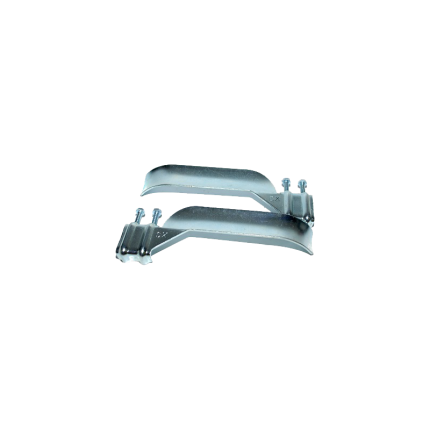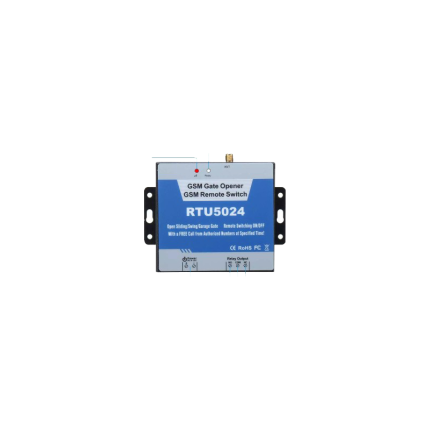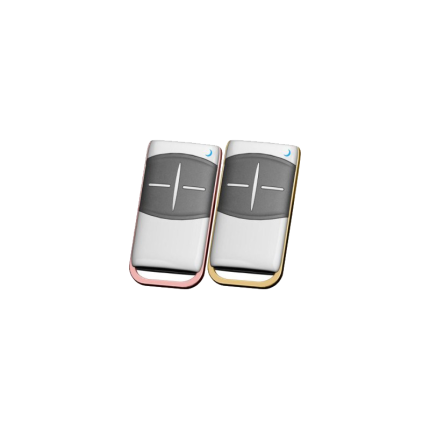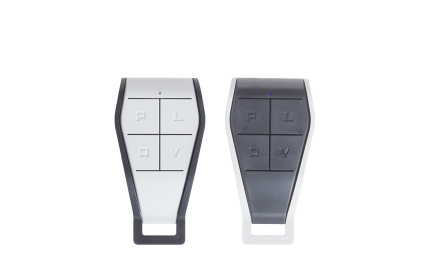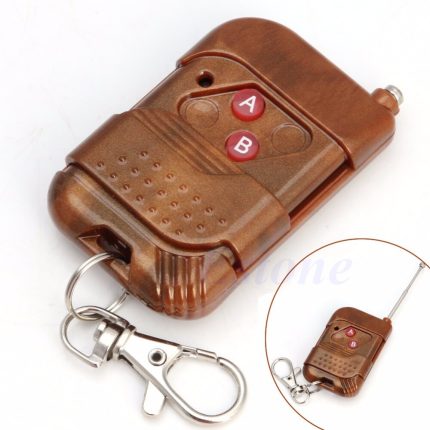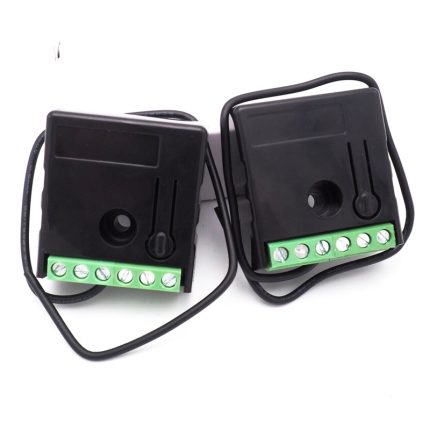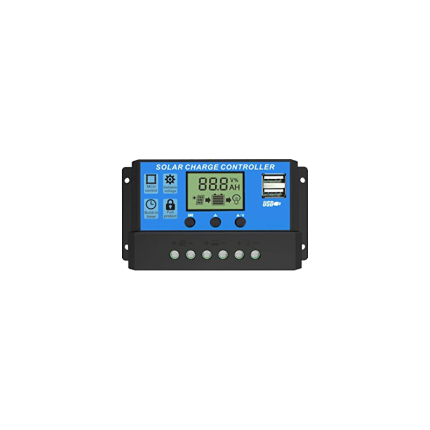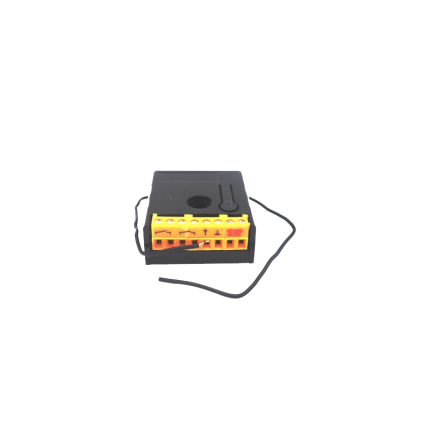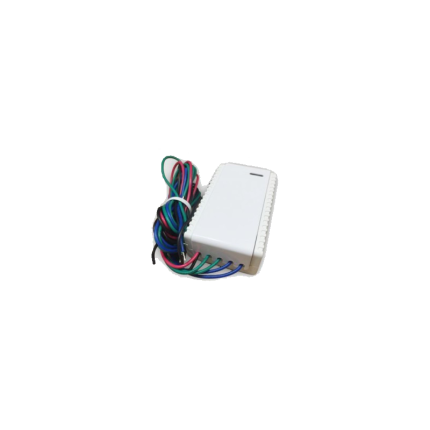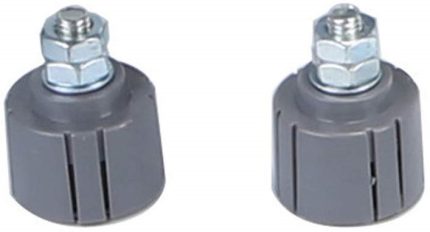gate automation
Wireless Doorbell
Ship or pick up from our office.
Wireless Doorbell
A wireless doorbell is a modern type of doorbell that operates without the need for physical wiring between the outdoor button and the indoor chime unit. Unlike traditional wired doorbells that rely on an electrical circuit, wireless doorbells use radio waves (or sometimes Wi-Fi or Bluetooth) to transmit a signal when the button is pressed. Here's a breakdown of its key components and how it works:- Transmitter (Doorbell Button): This is the part located outside your door that a visitor presses. It typically contains a small battery (though some "kinetic energy" versions generate power from the press itself) and sends a wireless signal when activated.
- Receiver (Chime Unit): This is the indoor component that produces the sound (chime or melody) when it receives the signal from the transmitter. Receivers can be battery-operated for portability or plug into a standard electrical outlet.
- When a visitor presses the doorbell button (transmitter), it sends a unique radio frequency (RF) signal.
- The signal travels wirelessly through the air.
- The receiver inside your home detects this signal.
- Upon receiving the signal, the receiver activates its chime or melody, alerting you to the visitor.
- Easy Installation: No need for complex wiring, drilling holes, or hiring an electrician. This makes them ideal for renters or anyone looking for a quick and simple setup.
- Flexibility and Portability: Since there are no wires, you can place the chime unit virtually anywhere in your home, and even move it around if needed. Many systems also allow for multiple receivers throughout a large house or property.
- Customization: Most wireless doorbells offer a variety of chime melodies and adjustable volume levels, allowing you to personalize the sound.
- Advanced Features (Smart Doorbells): Many modern wireless doorbells, often called "smart doorbells," integrate with Wi-Fi and offer additional features like:
- Video cameras: Allowing you to see who's at your door from your smartphone, even when you're not home.
- Two-way audio: Enabling you to speak with visitors remotely.
- Motion detection: Alerting you to activity outside your door.
- Smartphone notifications: Sending alerts to your phone when someone rings the bell or motion is detected.
- Integration with smart home systems: Connecting with other devices like smart lights or security systems.
- Enhanced Security: With features like video recording and remote monitoring, wireless doorbells can deter potential intruders and provide valuable evidence in case of an incident.
USB Gate Opener Remote
Ship or pick up from our office.
USB Gate Opener Remote
A USB gate opener remote control is a device that allows you to open and close automatic gates or garage doors by plugging a USB dongle into your car's USB port and using it as a remote.
USB Gate Opener Remote emits a sensing signal upon receiving a command from the USB port, which then triggers the gate opener to open or close the driveway gate.
Here's a more detailed explanation:
How it works:
-
USB Gate Opener Remote Dongle:The device typically includes a small USB dongle that plugs into your car's USB port.
-
Sensing Signal:When the USB is plugged in and the car is in the "on" mode, the dongle emits a sensing signal.
-
Receiver:The signal is received by a unit connected to the driveway gate motor.
-
Gate Motor Activation:The receiver then activates the gate motor, causing the driveway gate to open or close.
Key features:
-
Dual Control Modes:Some models offer both automatic and manual modes, allowing you to operate the gate either by proximity sensing or by pressing a button on the USB dongle.
-
Compact and Portable:The USB dongle is small and lightweight, making it easy to use and store in your car.
-
Easy Installation:It's designed for simple plug-and-play functionality, requiring no complex setup.
-
Replacement Accessory:The USB gate opener remote serves as a convenient replacement for traditional gate remote controls.
Sliding gate operator limit stopper bracket
Ship or pick up from our office.
Sliding gate operator limit stopper bracket
The gate operator system with a damaged limit stopper bracket can not work properly, and it will soon stop working. Most of the time, the main control board and the motor will be damaged because of this issue and have to be replaced. Sometimes errors come from the limit stopper bracket not working because they are damaged and needs only to be cleaned or readjustment.A sliding gate operator limit stopper bracket is a component that works with limit switches to prevent a sliding gate from over-extending its travel, ensuring it stops at the desired open and closed positions.
These brackets typically hold magnets or other sensor components that interact with the limit switches on the gate operator's control board. They help maintain the gate's smooth and safe operation by preventing it from hitting obstructions or going off its track.
Here's a more detailed explanation:
-
Purpose:The primary function of the limit stopper bracket is to define the boundaries of the gate's movement. It ensures the gate stops at the fully open and fully closed positions, preventing it from over-traveling.
-
How it works:The bracket holds a magnetic or other type of sensor that is triggered when the gate reaches its limit. This trigger sends a signal to the gate operator's control board, which then stops the motor.
-
Components:
- Bracket: The physical structure that holds the sensor.
- Sensor: A device (often a magnet) that interacts with the limit switch.
- Limit Switch: A switch on the gate operator's control board that is activated by the sensor.
- Bracket: The physical structure that holds the sensor.
-
Importance:
- Safety: Prevents the gate from hitting objects or going off track, reducing the risk of damage or injury.
- Reliability: Ensures consistent and reliable gate operation by defining the travel limits.
- Protection: Protects the gate, operator, and surrounding objects from damage due to over-travel.
- Safety: Prevents the gate from hitting objects or going off track, reducing the risk of damage or injury.
GSM Gate Controller RTU5024
Ship or pick up from our office.
GSM Gate Controller RTU5024
The GSM Gate Controller RTU5024 is a device that allows you to control gates, doors, and other electrical equipment remotely using a mobile phone. It functions as a GSM relay switch, meaning it utilizes the Global System for Mobile Communications (GSM) network to receive commands and activate a built-in relay. How it Works ⚙️ The RTU5024 operates by accepting calls from authorized phone numbers. When an authorized user dials the SIM card number installed in the RTU5024, the device recognizes the caller ID, rejects the call (so there are no call charges), and then activates its relay. This relay can be connected to the mechanism of a gate, door, or other machinery, effectively opening, closing, or switching it on/off. Users can also manage the device and its authorized numbers via SMS commands or a dedicated smartphone app. Key Features ✨- No Call Charges: The device rejects calls from authorized numbers after the first ring, meaning there are no charges incurred for operating it via phone call.
- Caller ID Authentication: It uses caller ID for identification, ensuring only authorized numbers can control the device. Unknown callers are ignored.
- Remote Operation: Can be operated from anywhere with GSM network coverage, with no distance limitations.
- User Management: Authorized phone numbers (typically up to 200, though some versions support more) can be added or removed via SMS text commands or through a smartphone app.
- Relay Output: Features one output with a relay rating (e.g., 3A/240VAC) for connecting to various switches or machines.
- SMS Confirmation: The device can be configured to send an SMS confirmation to the owner or authorized number after a relay action.
- Programmable Relay Time: The duration for which the relay remains open or closed is often programmable.
- Quad-band GSM: Works on universal GSM frequencies (850/900/1800/1900MHz), making it compatible with most GSM networks worldwide. Some versions also support 3G or 4G.
- Smartphone App: Available with companion apps for Android and iOS for easier configuration and control.
- No Physical Remote Needed: Eliminates the need for multiple physical remote controls or keys for different users.
- Access Control: Remotely opening/closing swing/sliding gates, garage doors, shutters, and pedestrian doors for residential, commercial, or industrial properties.
- Car Parking Systems: Controlling barriers and access for parking lots.
- Remote Equipment Control: Switching on/off various remote equipment like street lights, motors, pumps, fans, inverters, PLCs, and air conditioners.
- Agriculture: Remote control of agricultural pumps and irrigation systems.
- Business: Managing electronic boxes, billboards, and LED signs remotely.
- Security: Can be integrated into basic security systems for remote monitoring or activation of alarms.
Original Gate Opener Remote Control
Ship or pick up from our office.
Original Gate Opener Remote Control
*433 MHz *2-4 Buttons *(More than 10 different designs)A gate opener remote is a handheld device that allows you to remotely open and close an automatic gate.
It sends a radio signal to a receiver connected to the gate's motor, triggering the gate to move. These remotes are a convenient way to control access to properties, especially when entering or exiting with a vehicle.
Here's a more detailed explanation:
-
Function:The remote transmits a radio signal to a receiver unit connected to the gate opener motor.
-
Convenience:They eliminate the need to manually open or close the gate, providing convenience and security.
-
Compatibility:Remotes must be compatible with the gate opener's frequency and coding system.
-
Types:There are various types of remotes, including single-button (for basic open/close) and multi-button (for more complex functions like stopping or partially opening the gate).
-
Programming:Remotes need to be programmed to work with the specific gate opener.
-
Frequency:Most gate openers use 433.92 MHz frequency, but some older systems might use different frequencies.
-
Range:The range of the remote can vary depending on obstructions like trees or buildings.
Gate Opener Remote Control 1400FT315/2-CH
Ship or pick up from our office.
Gate Opener Remote Control 1400FT315/2-CH
A high-range gate opener remote control 1400FT315/2-CH allows you to operate your gates from a greater distance than standard remotes, typically offering a range of several hundred feet or even up to a mile or more.
These remotes are often used in situations where the gate is located far from the entrance or when there are obstructions between the remote and the receiver.
Here's a more detailed explanation about Gate Opener Remote Control 1400FT315/2-CH:
What makes it high-range?
-
Stronger Transmitter:High-range remotes have a more powerful transmitter than standard remotes, allowing them to send a stronger signal over a longer distance.
-
Specialized Receiver:These remotes often work with a specialized receiver that is more sensitive and capable of picking up weaker signals.
-
Frequency:High-range remotes typically operate on a specific frequency (e.g., 433MHz or 315MHz) that is less prone to interference and allows for better transmission.
Benefits of high-range remotes like as the Gate Opener Remote Control 1400FT315/2-CH:
-
Increased Convenience:You can open your gate from a greater distance, which is particularly useful for large properties or when driving up to the gate.
-
Improved Security:High-range remotes can help prevent unauthorized access by allowing you to activate the gate from a safe distance.
-
Enhanced Flexibility:They can be used in a wider range of situations, such as when you need to open the gate for deliveries or visitors.
Factors affecting range:
-
Line of Sight:The range is usually maximized when there is a clear line of sight between the remote and the receiver.
-
Obstructions:Walls, trees, and other obstructions can reduce the range of the remote.
-
Weather Conditions:Extreme weather conditions like heavy rain or snow can also affect the range.
-
Antenna Placement:Proper placement of the antenna on the receiver can help improve the range.
Radio receiver RGRR1C
Radio receiver RECT102-V2.0 – CH2
Solar charge controller
Ship or pick up from our office.
Solar charge controller
A solar charge controller is an electronic device that regulates the flow of electricity from solar panels to a battery bank, protecting the batteries from overcharging and over-discharging. It's a crucial component in off-grid and hybrid solar power systems. Key Functions of a Solar Charge Controller- Preventing Overcharging: Solar panels can produce varying amounts of electricity depending on sunlight intensity. If this unregulated power is sent directly to batteries, it can lead to overcharging, which damages the batteries, reduces their lifespan, and can even pose a safety risk (e.g., overheating, gassing). The charge controller monitors the battery's voltage and reduces or stops the current flow when the battery reaches its full charge.
- Preventing Over-discharging: Some charge controllers also have a low voltage disconnect (LVD) feature that protects the battery from being excessively drained. Deep discharging can also cause irreversible damage to batteries. The controller will disconnect the load when the battery voltage drops below a certain threshold.
- Optimizing Charging: Modern charge controllers use advanced technologies to ensure the batteries are charged efficiently, maximizing the energy harvested from the solar panels.
- Reverse Current Prevention: At night, when solar panels aren't producing power, there's a risk of electricity flowing back from the batteries to the panels, which would drain the batteries. Charge controllers include a diode or similar mechanism to prevent this reverse current flow.
- System Protection: Many controllers offer additional safeguards against issues like short circuits, overloads, and reverse polarity.
- How they work: PWM controllers regulate the voltage by rapidly switching the solar panel input on and off. The "width" of these pulses is adjusted to control the average voltage and current sent to the battery. When the battery is nearly full, the pulses become shorter, reducing the charging current.
- Advantages: They are generally less expensive and simpler in design, making them suitable for smaller, less complex solar systems (e.g., small RV setups, solar lighting).
- Disadvantages: They are less efficient than MPPT controllers, especially in conditions where the solar panel's voltage significantly differs from the battery voltage. They essentially "pull down" the solar panel's voltage to match the battery, leading to energy loss.
- How they work: MPPT controllers are more sophisticated. They can "track" the maximum power point (MPP) of the solar panel. The MPP is the optimal combination of voltage and current at which the solar panel produces the most power. The MPPT controller converts any excess voltage from the solar panels into additional current, thereby maximizing the energy sent to the battery. It's like an automatic transmission that adjusts the gear to get the most power from the engine.
- Advantages: They are significantly more efficient than PWM controllers (often 10-30% more, especially in colder temperatures or when the battery is deeply discharged). They are ideal for larger, more complex solar systems and those where the solar panel array voltage is higher than the battery bank voltage. This also allows for longer wiring runs with less power loss.
- Disadvantages: MPPT controllers are more expensive due to their advanced technology.
Radio receiver RGRR2C
Radio receiver R5130
Sliding gate operator limit sensor – Magnetic mechanism
Ship or pick up from our office.
Sliding gate operator limit sensor - Magnetic mechanism
A sliding gate operator limit sensor, often a limit switch, is a crucial component that signals the gate operator when the gate has reached its fully open or fully closed position, stopping the motor and preventing over-travel. These sensors ensure the gate stops at the correct positions, preventing damage to the gate and surrounding structure.
Here's a more detailed explanation:
-
Function:Limit sensors, like limit switches, detect when the gate reaches its extreme open or closed positions.
-
How it works:When the gate reaches the limit, the sensor sends a signal to the gate operator's control board, which then stops the motor.
-
Importance:Without limit sensors, the gate might continue to move, potentially hitting the end posts or other obstructions, causing damage.
-
Types:Common types include magnetic limit switches and photoelectric sensors (photo eyes).
-
Magnetic Limit Switches:These utilize magnets placed on the gate and a magnetic sensor on the operator. When the magnet aligns with the sensor, it triggers the limit switch.
-
Photoelectric Sensors (Photo Eyes):These use infrared beams to detect obstructions. When the beam is broken (e.g., by the gate), the sensor signals the operator to stop.
-
Installation:Proper installation and adjustment of limit sensors are crucial for the reliable operation.
-
Maintenance:Regular inspection and maintenance of limit sensors are recommended, as they can wear out or become misaligned over time.



